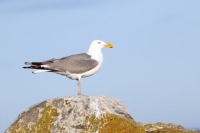
(Photo: Ralph Eldridge)
Herring Gull
Larus argentatus
This large gull has a white body, pink legs, a curved yellow beak, and grey wings with black tips. Some individuals (juveniles and non-breeding adults) have a brown speckled body. The wingspan of adults is at least 147 centimetres, and their body length is 64 centimetres.
Authority
Pontoppidan, 1763
Classification Details
Phylum: Chordata (chordates); Subphylum: Vertebrata (vertebrates); Class: Aves (birds).
Habitat
Found from the Canadian Atlantic south to the Gulf of Mexico. Very common in the Bay of Fundy. They prefer to build their nests on rocky cliffs, islets, and islands. Yet, they may move into urban areas.
Diet
Both a scavenger and a predator. Feeds on fish, crustaceans, molluscs, insects, and dead birds. You can sometimes see them stomping around on dirt to make worms come up to the surface so they can eat them. Their stomping tricks the worms into thinking that it is raining, causing them to surface.
Reproduction
Sexes are separate. Males and females form pairs that build a nest together. Pairs build nests on the ground in treeless habitat. Sometimes pairs nest on man-made structures like rooftops. They construct simple, bowl-like nests out of vegetation. In May to June, the female lays one to three eggs in the nest and incubates them for around 29 days. Hatched chicks need brooding for the first three to four days until they can regulate their body temperature. After this, the parents brood them only at night. Both parents look after the chicks and feed them with regurgitated food until they are 11 to 12 weeks old. Chicks fledge at around 45 days. Herring gulls breed in a variety of habitats over much of Canada.
Fun Facts
The colour of the herring gull's eggs can act as a bioindicator of pollution. This means that they will change colour in the presence of particular pollutants.
References
Hanley D and Doucet SM (2012) Does environmental contamination influence egg coloration? A long-term study in herring gulls. Journal of Applied Ecology 49, 1055–1063.
Nisbet ICT, Weseloh DV, Hebert CE, Mallory ML, Poole AF, Ellis JC, Pyle P and Patten MA (2017). Herring Gull (Larus argentatus), version 3.0. In The Birds of North America (P. G. Rodewald, Editor). Cornell Lab of Ornithology, Ithaca, NY, USA. https://doi.org/10.2173/bna.hergul.03
Sweet NA (2008) Larus argentatus Herring gull. In Tyler–Walters H. and Hiscock K. (eds) Marine Life Information Network: Biology and Sensitivity Key Information Reviews, [on–line]. Plymouth: Marine Biological Association of the United Kingdom. Available from: https://www.marlin.ac.uk/species/detail/2209 Accessed online 21 January 2020.
Van Guelpen L, Pohle G, Vanden Berghe E and Costello MJ (2005) Marine Species Registers for the North Atlantic Ocean. World Wide Web electronic publication. http://www.vliz.be/vmdcdata/narms/
World Register of Marine Species. Larus argentatus Pontoppidan, 1763 – WoRMS Taxon Details. http://marinespecies.org/aphia.php?p=taxdetails&id=137138 Accessed online 21 January 2020.


